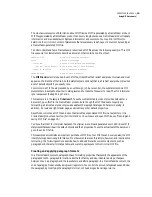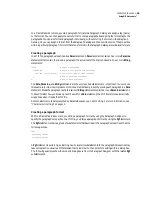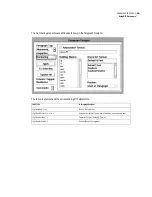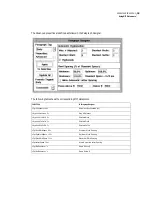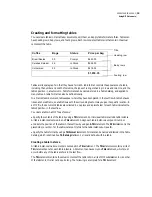
33
ADOBE FRAMEMAKER 6.0
Using MIF Statements
<Tbl
<TblID
…
>
# A unique ID for the table
<TblFormat
…
>
# The table format
<TblNumColumns
…
>
# Number of columns in this table--required
<TblColumnWidth
…
>
# Column width, one for each column
<TblH
# The heading; omit if no heading
<Row
# One Row statement for each row
<Cell
…
>
# One statement for each cell in the row
> # end of Row
<TblBody
# The body of the table
<Row
…
>
# One for each row in body
> # end of TblBody
<TblF
# The footer; omit if no footer
<Row
…
>
# One for each row in footer
> # end of TblF
> # end of Tbl
The
TblID
statement assigns a unique ID to the table instance. The
TblFormat
statement provides the table
format. You can use the
TblFormat
statement to apply a table format from the Table Catalog, apply a
format from the catalog and override some of its properties, or completely specify the table format locally.
Because the tables in a document often share similar characteristics, you usually store table formats in the
Table Catalog. Table instances can always override the applied format.
The
TblNumColumns
statement specifies the number of columns in the table instance. It is required in
every table.
The
TblH
,
TblBody
, and
TblF
statements contain the table heading, body, and footer rows. If a table does
not have a heading or footing, omit the statements.
Here’s an example of a simple table that uses a default format from the Table Catalog. The table has one
heading row, one body row, and no footing rows:
You can use the following MIF statements to create this simple table:
Coffee
Price per Bag
Brazil Santos
$455.00
Summary of Contents for FRAMEMAKER 6.0
Page 1: ...MIF Reference Online Manual FrameMaker 6 0 Adobe ...
Page 15: ...15 ADOBE FRAMEMAKER 6 0 Introduction ...
Page 159: ...159 ADOBE FRAMEMAKER 6 0 MIF Book File Statements ...
Page 232: ...232 ADOBE FRAMEMAKER 6 0 MIF Asian Text Processing Statements ...
Page 252: ...252 ADOBE FRAMEMAKER 6 0 Examples ...

